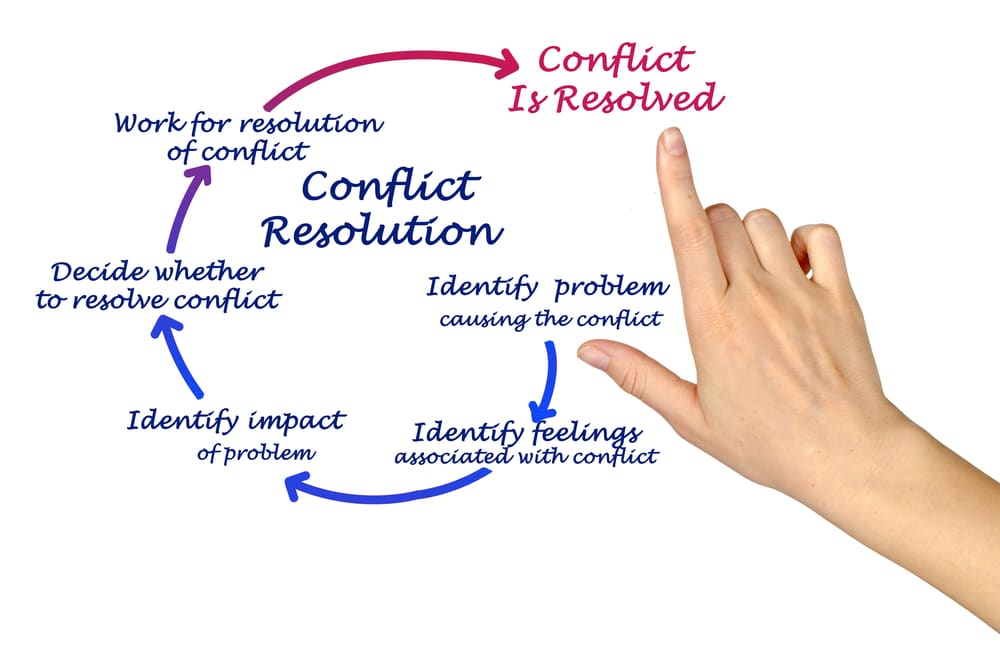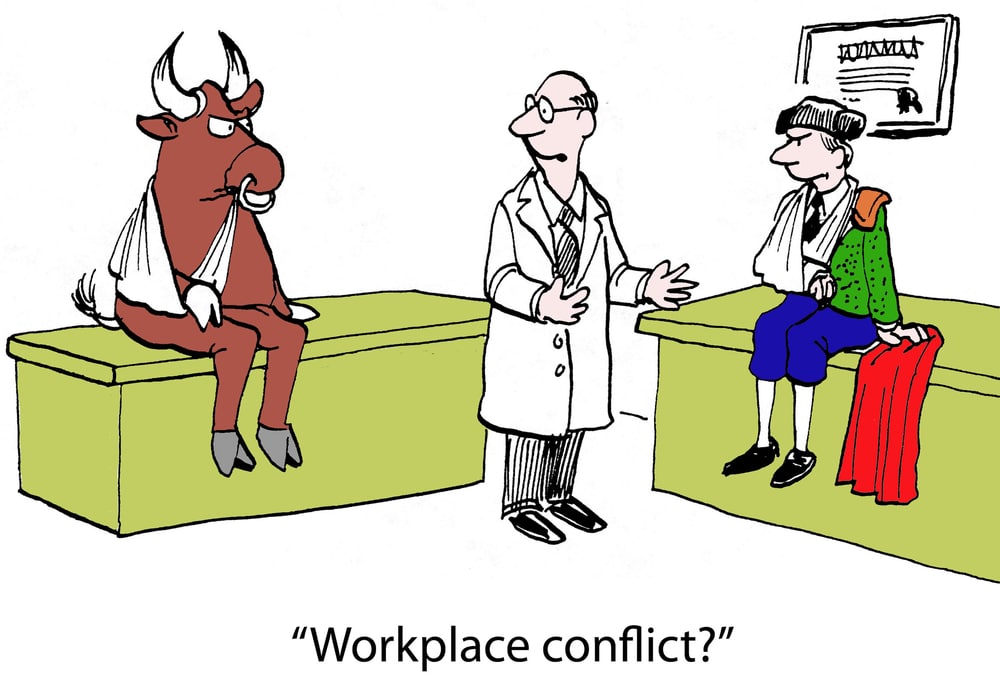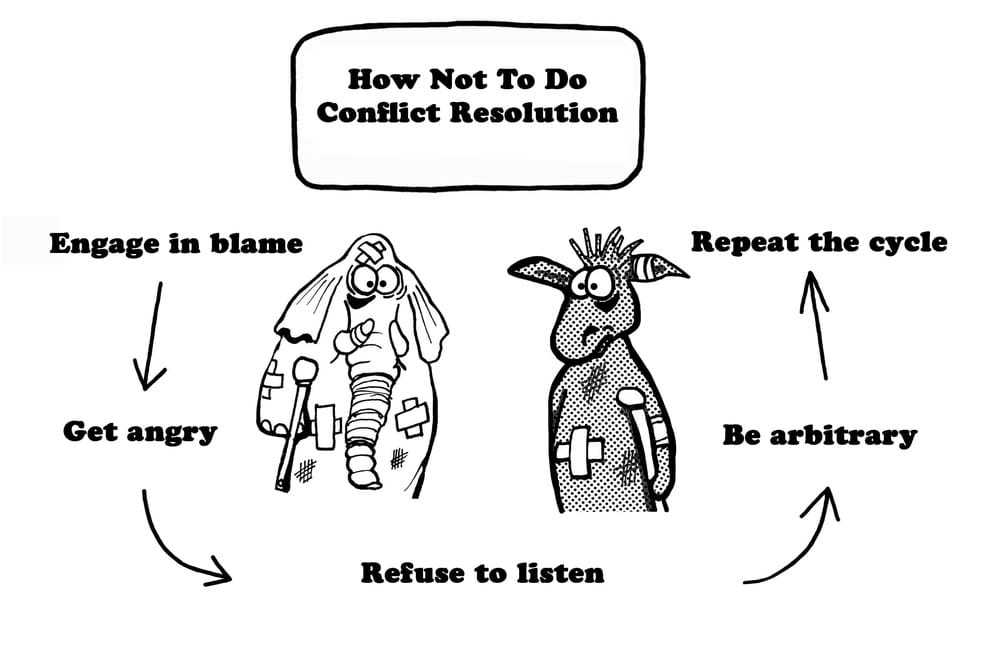Conflict Management Techniques For Employees

It’d be wonderful if we could all get along all the time.
Unfortunately, it’s a fact of life for almost any workplace that conflicts will arise occasionally. When they do, you need a robust conflict resolution process to prevent a small dispute from escalating into a toxic environment. Conflict management for employees is so important that we created a full training course on conflict resolution.
Sympathy and respect for all parties involved is essential. Authoritative management will be needed. A well-established, tried-and-tested strategy will make your life so much easier.
This article will discuss every aspect of settling workplace grievances. We’ll look at the five conflict resolution strategies outlined in the Thomas-Kilmann model and show you how and when to apply these in your workplace. We’ll provide a step-by-step guide to help you establish best practices. And we’ll show you every benefit of having a well-defined conflict management strategy in your workplace.
Let’s sit down and talk it over.
What is Conflict Management?
Conflict management is both a skill and a duty. It means ensuring that all parties involved in any dispute find a satisfactory compromise when an issue arises.
It’s a skill because it needs to be learned. Some people have a natural ability to defuse and de-escalate situations, but anyone can become an effective mediator.
It’s a duty because those in management roles are responsible for ensuring that their workplace is harmonious and functional. While staff should be expected to behave like adults and resolve problems reasonably, management must step in when this isn’t happening.
A significant part of any successful resolution is showing staff members how to resolve conflicts alone. It’s also important to teach employees about the non-verbal or body language cues they give to other employees. The best conflict resolution strategies aren’t just random interventions but opportunities to develop staff and colleagues and promote a healthier, more mature workplace.

Why is Conflict Resolution Important?
It’s easy to see the difference between a workplace that lets disputes fester and deepen compared to one that actively practices conflict management.
Conflicts that arise in the workplace need to be mediated, or they risk turning toxic. Simmering grievances contributes to an unhealthy culture that may include:
- Blame games
- Factions forming among staff
- Distrust between staff and management
- Low motivation and productivity
- Poor staff retention
Without an effective conflict management strategy in place, managers may feel powerless to change their workplace culture. It’s essential that managers take steps to understand the root cause, intervene where appropriate, and help all parties understand both how compromise can be achieved and why this is so important.
What Causes Workplace Conflicts?
Each workplace conflict is unique and should be treated as such. However, here are some common causes of disputes:
- Perceived laziness. Workers become resentful when they perceive their colleagues to be getting paid the same but not putting the effort in. This is especially common in workplaces where constant cooperation is required, e.g. food service.
- Perceived favoritism. If staff believe that one team member is being given preferential treatment by management, it can cause divisions within the team.
- Unprofessional behavior. Employees expect to be treated with respect and professionalism in the workplace. If their colleagues show them rudeness or disrespect, they will naturally become resentful. While unprofessional behavior may fall within the remit of conflict resolution, inappropriate or aggressive behavior is not a “conflict” – it becomes a disciplinary matter for the offending party.
- Non-workplace issues. Employees often socialize outside work, and external conflicts can spill over into the workplace. Likewise, when an employee is in a relationship with a colleague, problems within the relationship can become visible at work.
- Simple misunderstandings. Perhaps someone was having a bad day and was a bit “off” with someone. Perhaps someone could have phrased a statement better. Sometimes, there is a completely innocent explanation for an escalating conflict left unresolved because nobody intervened.
There’s a critical difference between conflict resolution and staff not necessarily “getting on” with each other. Staff members may not always see eye-to-eye, but as long as each party behaves professionally and keeps their distance, there’s no call for management to force staff to “be friends.”

Thomas-Kilmann Model Dimensions for Conflict Resolution
So how do managers know when to address conflicts and intervene, and when it’s best to live and let live?
The Thomas-Kilmann Conflict Mode Instrument was developed by researchers in 1974. It lays out an axis of “Assertiveness” measured against “Cooperation,” with five conflict resolution strategies identified across the graph:
- Avoiding
- Competing
- Accommodating
- Collaborating
- Compromising
Note that this model describes strategies that can be employed by management and the parties involved in the conflict. Management’s role is to ensure that individuals use the appropriate resolution strategy and intervene where no effort is being made to resolve the conflict.
First, let’s establish how assertiveness and cooperation are used in successfully managing conflict.
Assertiveness
Assertiveness is a necessary quality in conflict resolution – but far more important is knowing when it’s time to be assertive.
An assertive approach is especially helpful when conflicts:
- Need to be resolved quickly
- Are especially petty in nature
- Carry a strong ethical dimension
- Are obviously more to do with one individual than the other(s)
However, assertiveness is less focal when conflicts are very personal (e.g., involving an out-of-work relationship) or where no party is strictly “to blame.” Overassertive behavior from management can create more conflicts than it resolves, as employees may feel like their point of view is being ignored or neglected in favor of brushing an issue aside.
Cooperation
Cooperation isn’t just the preserve of the manager in charge of resolving conflicts; it’s required of all parties involved.
Conflicts that require cooperation are those where the goal is to find a peaceful middle ground. Cooperation means fostering an open dialogue between disagreeing parties to help each understand the other’s perspective.
Common strategies used in cooperative resolution include active listening, establishing ground rules, and ensuring all parties’ emotions are understood by others involved. Conflicts often arise because someone doesn’t understand “why” something is irritating or upsetting to another. It requires collaborative efforts from all parties, including the mediator, to find a solution in these situations.
Cooperation is less of a priority when one party is clearly at fault. An overly cooperative approach may make the offended party feel as if their complaint is being given equal weight to the offending party’s transgressions – a more assertive approach is required in these cases.

What are 5 Conflict Management Techniques? The Thomas-Kilmann Mode Instrument
The Thomas-Kilmann model suggests 5 conflict resolution strategies commonly adopted in the workplace. While the ideal is given as “compromise,” there’s a time and a place for each of the strategies on this list.
Avoiding
Conventional wisdom dictates that we shouldn’t avoid our problems. However, there are instances where avoiding a problem is actually the best way to handle it.
This applies especially to instances like random, heated disputes. Suppose one person is having a bad day, and someone else accidentally says something that touches a sore spot. The first person responds with surprising hostility, and the second person believes that the other is overreacting.
If these colleagues usually get on, it may be best to just call it a day and move on. Ideally, the next day, the colleagues will meet again, and both will recognize that it was a simple misunderstanding. Management does no need to get involved, so avoiding is the best solution.
However, avoiding has limits and drawbacks and can easily become a lose-lose strategy. If someone avoids an issue that is persistently upsetting them, this will develop into resentment. The conflict can’t be resolved because it hasn’t been identified.
Likewise, if a manager can see an issue but avoids addressing it, the problem will continue until someone snaps. Management will also appear weak, and workplace morale will be undermined.
Accommodating
Accommodating is something of a win-lose strategy. The “win” is that the conflict is resolved – the “lose” is that one party has to give in and let the other have things their way.
This can still be a useful technique, especially for very short-term conflicts. For instance, if two employees both have a reason they want to leave work early that day, but only one is permitted to leave, one may eventually have to “yield” and say, “You can have this one.”
Accommodating may be effectively used as a favor-based and temporary solution. For instance, the people involved in the above scenario may agree that the next time they have such a dispute, the person who gave in this time will have priority.
Again, this method has drawbacks. If one party repeatedly gives in to the other party, it establishes an unequal dynamic. Management should understand how to identify where employees are accommodating each other and, if necessary, intervene and point out that each party needs to accommodate the other for it to be fair.
Competing
Competing is one of the most prevalent responses to conflict. It’s one of the most assertive strategies and can be a highly effective management tool when mediating conflicts – what’s known as “pulling rank.”
It’s also often used by staff members determined to prove that their point of view is the “correct” one. In these situations, competing can often be overly assertive and lack the necessary cooperative elements; it becomes a case of “who can shout the loudest” and expects other parties to be accommodating.
Overly assertive competing is often identified in male-dominated workplaces and industries and can be off-putting for new hires and impact a company’s ability to find new talent.
Management should be able to identify where competing moves from healthy confidence in one’s own point of view to a desire to “be right.”
In these instances, an assertive approach that puts overzealous individuals in their place can actually be highly effective. Still, management should lead by example in respecting workers’ perspectives and establishing the importance of cooperation.
Collaborating
Collaborating is one of the most productive but intensive conflict resolution techniques. It requires mutual respect between conflicting parties to have an open discussion and establish a way forward that makes best use of each party’s ideas – nothing is off-limits.
Collaborating is often referred to as a “win-win strategy” because it seeks to find a common understanding without either party having to give too much ground. It requires a significant level of assertiveness from involved parties but also requires a high level of collaboration (as the name suggests!)
Skilled managers often use this technique to prevent conflict between ambitious and naturally assertive employees. Collaborating can harness all parties’ skill sets and ensure that assertiveness manifests as positive energy rather than hostility and bickering.
Compromising
Compromising is the “ideal” solution, especially for complex issues. One of the most common reasons conflict develops in the workplace is that employees refuse to talk things out. Positions become entrenched and mutual trust degrades.
Management can introduce compromising to workers with different priorities, viewpoints, or even core values. Compromising involves ensuring that each individual understands the other person’s point of view and that personal differences are seen as secondary to creating a happy, successful workplace.

How to Resolve Conflict: Step-by-Step Guide
The Thomas-Kilmann model is one of the best-known administrative procedures for conflict resolution and is used in training by notable organizations like the Project Management Institute.
However, along with a structured understanding of different approaches to conflict resolution, managers should have a step-by-step plan for how to act when conflict arises.
That’s exactly what we provide below. Avoid future conflicts and develop emotional intelligence in your workplace by being prepared.
1. Establish the Involved Parties
All involved parties must be known to find a reasonable solution. If an unidentified party is a major cause of the conflict, solving problems becomes much more difficult.
2. Acknowledge the Issue
Both management and the individuals concerned should acknowledge that there is a problem. Even minor issues should be acknowledged, as what may be a small matter to one person may be deeply aggravating to another.
3. Define Grievances
All parties involved should be allowed to define their grievances. This helps resolve conflict swiftly and may even present a quick solution – if parties don’t understand each others’ grievances, they won’t know how to address them moving forward.
4. Set Up a Safe Space for Discussion
All involved parties should understand that they’ll be listened to and that this is a bid to resolve an issue rather than a telling-off. Focus on helping individuals understand that problem-solving is the goal rather than punishment – people tend to respond better when they believe they’ll be listened to.
If the issue involves out-of-work disputes, e.g. family conflicts, it should be established that the workplace isn’t the proper place for these disputes, but that help is available. Separation of individuals’ roles is often helpful in these situations.
5. Ensure Everyone’s Voice is Heard
Each person’s perspective is important when resolving conflicts. All people involved should be given a chance to speak; different perspectives will help management find common ground for employees and negotiate a compromise.
6. Propose a Solution to Each Party
Whenever a conflict occurs, finding a solution that satisfies all parties is the best course of action.
In some cases, this means finding neutral ground. In others, especially when collaboration is involved, it means building strong relationships by encouraging each party to bounce ideas off each other and resolve the issue through healthy dialogue.
This requires more effort on the part of the individuals involved, but it can be one of the most constructive problem-solving techniques for individuals and the company.
7. Find a Compromise
Compromise is typically the best way to resolve conflicts. It may involve each party having to give up a little ground, but it should be stressed that the many benefits of cooperation (e.g. reduced stress levels or a more harmonious work atmosphere) outweigh the small sacrifices each party may have to make.
8. Draw a Line
Assertiveness is an important part of conflict resolution for each party involved. Without it, grievances will never be aired, and it will be impossible to resolve a conflict.
However, it’s also essential for management to be assertive when intervening in conflicts. While other methods may help resolve the conflict to each party’s satisfaction, management must be clear that a line should be drawn under the conflict when a compromise has been found.
Benefits of Strong Conflict Management Practices
Let’s focus on how strong conflict resolution practices can benefit your workplace.
Improved Staff Morale
Nobody likes working in an environment where people are at each other’s throats. It drains morale and decreases motivation.
Better Collaboration
Collaboration is a great way to resolve conflicts – it makes use of each party’s talents and drives productivity by having individuals work through disagreements towards a common goal.
Establishes Respect & Authority
If management can’t effectively intervene in conflicts, it will be perceived as weak and ineffective. This engenders a poor working culture.
If management is seen as an authority that can resolve a conflict and promote harmony, it’s good for everyone.
Greater Staff Retention
If a workplace becomes especially toxic, staff will leave. This may include people who aren’t involved in the conflict and some of your most talented employees.
Your Company is More Attractive to New Hires
Former workers may also leave reviews of your company on job sites. “Toxic culture” is a common complaint – this puts new hires off.
New staff can also tell when a workplace conflicts with itself when they arrive. You’ll have trouble attracting top talent without conflict resolution practices.
Final Thoughts
Conflict management is an essential skill for managers to develop. It’s a duty they have to their staff.
Any workplace needs a structured, well-informed conflict resolution strategy in place. Help your workers feel respected, heard, and understood – implement an effective strategy today.
FAQ
It all starts with identifying each party involved in the conflict and listening to their grievances. From there, you can decide on the best strategy.
1) Conflict
2) Coexistence
3) Competition
4) Cooperation
And don’t forget to compromise!
Numerous conflict resolution strategies exist, but most systems are based on the Thomas-Kilmann model.